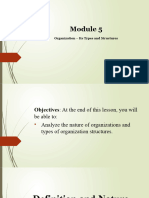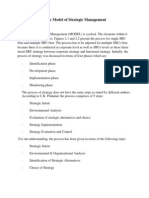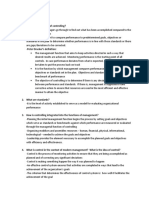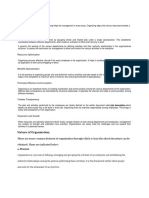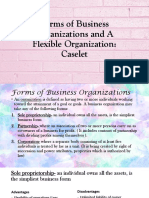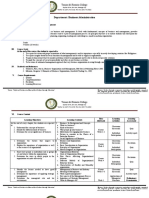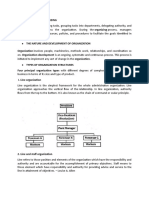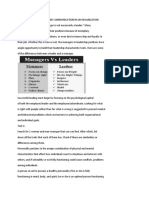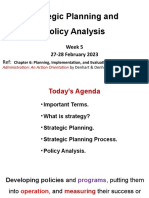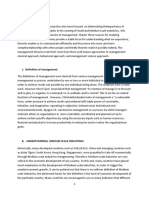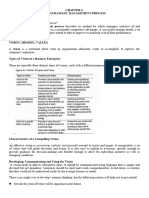Module 3-Planning and Decision Making
Uploaded by
Rishabh MittalModule 3-Planning and Decision Making
Uploaded by
Rishabh MittalSem 1 Module 3 Business Management
MODULE 3
PLANNING
Learning Objectives:
• To learn meaning and types of planning
• To understand the nature and steps in planning process
• To learn the concepts of MBO and MBE
• To learn the meaning and types of Decisions
• To understand the importance and steps in decision Making
Planning means looking ahead and chalking out future courses of action to be followed. It is a
preparatory step. It is a systematic activity which determines when, how and who is going to
perform a specific job. Planning is a detailed programme regarding future courses of action.
It is rightly said “Well plan is half done”. Therefore planning takes into consideration available
& prospective human and physical resources of the organization so as to get effective co-
ordination, contribution & perfect adjustment. It is the basic management function which
includes formulation of one or more detailed plans to achieve optimum balance of needs or
demands with the available resources.
Definition
According to Urwick, “Planning is a mental predisposition to do things in orderly way, to think
before acting and to act in the light of facts rather than guesses”. Planning is deciding best
alternative among others to perform different managerial functions in order to achieve
predetermined goals.
According to Koontz &O’Donell, “Planning is deciding in advance what to do, how to do and
who is to do it. Planning bridges the gap between where we are to, where we want to go. It
makes possible things to occur which would not otherwise occur”.
Nature or Characteristics of Planning
The following are the essential characteristics of planning which describe the nature of planning:
1. Planning is primary function of management:
The functions of management are broadly classified as planning, organization, direction and
control. It is thus the first function of management at all levels. Since planning is involved at all
managerial functions, it is rightly called as an essence of management.
Note: Strictly for Private Circulation Only Page 1
Sem 1 Module 3 Business Management
2. Planning focuses on objectives:
Planning is a process to determine the objectives or goals of an enterprise. It lays down the
means to achieve these objectives. The purpose of every plan is to contribute in the achievement
of objectives of an enterprise.
3. Planning is a function of all managers:
Every manager must plan. A manager at a higher level has to devote more time to planning as
compared to persons at the lower level. So the President or Managing director in a company
devotes more time to planning than the supervisor.
4. Planning as an intellectual process:
Planning is a mental work basically concerned with thinking before doing. It is an intellectual
process and involves creative thinking and imagination. Wherever planning is done, all activities
are orderly undertaken as per plans rather than on the basis of guess work. Planning lays down a
course of action to be followed on the basis of facts and considered estimates, keeping in view
the objectives, goals and purpose of an enterprise.
5. Planning as a continuous process:
Planning is a continuous and permanent process and has no end. A manager makes new plans
and also modifies the old plans in the light of information received from the persons who are
concerned with the execution of plans. It is a never ending process.
6. Planning is dynamic (flexible):
Planning is a dynamic function in the sense that the changes and modifications are continuously
done in the planned course of action on account of changes in business environment.
As factors affecting the business are not within the control of management, necessary changes
are made as and when they take place. If modifications cannot be included in plans it is said to be
bad planning.
7. Planning secures efficiency, economy and accuracy:
A pre- requisite of planning is that it should lead to the attainment of objectives at the least cost.
It should also help in the optimum utilisation of available human and physical resources by
securing efficiency, economy and accuracy in the business enterprises. Planning is also
economical because it brings down the cost to the minimum.
8. Planning involves forecasting:
Planning largely depends upon accurate business forecasting. The scientific techniques of
forecasting help in projecting the present trends into future. ‘It is a kind of future picture wherein
Note: Strictly for Private Circulation Only Page 2
Sem 1 Module 3 Business Management
proximate events are outlined with some distinctness while remote events appear progressively
less distinct.”
9. Planning and linking factors:
A plan should be formulated in the light of limiting factors which may be any one of five M’s
viz., men, money, machines, materials and management.
10. Planning is realistic:
A plan always outlines the results to be attained and as such it is realistic in nature
Basic Steps in the Management Planning Process
Management planning is the process of assessing an organization's goals and creating a realistic,
detailed plan of action for meeting those goals. Much like writing a business plan, a management
plan takes into consideration short- and long-term corporate strategies. The basic steps in the
management planning process involve creating a road map that outlines each task the company
must accomplish to meet its overall objectives.
• Establish Goals
The first step of the management planning process is to identify specific company goals. This
portion of the planning process should include a detailed overview of each goal, including the
reason for its selection and the anticipated outcomes of goal-related projects. Where possible,
objectives should be described in quantitative or qualitative terms. An example of a goal is to
raise profits by 25 percent over a 12-month period.
• Identify Resources
Each goal should have financial and human resources projections associated with its completion.
For example, a management plan may identify how many sales people it will require and how
much it will cost to meet the goal of increasing sales by 25 percent.
• Establish Goal-Related Tasks
Each goal should have tasks or projects associated with its achievement. For example, if a goal is
to raise profits by 25 percent, a manager will need to outline the tasks required to meet that
objective. Examples of tasks might include increasing the sales staff or developing advanced
sales training techniques.
• Prioritize Goals and Tasks
Prioritizing goals and tasks is about ordering objectives in terms of their importance. The tasks
deemed most important will theoretically be approached and completed first. The prioritizing
Note: Strictly for Private Circulation Only Page 3
Sem 1 Module 3 Business Management
process may also reflect steps necessary in completing a task or achieving a goal. For example, if
a goal is to increase sales by 25 percent and an associated task is to increase sales staff, the
company will need to complete the steps toward achieving that objective in chronological order.
• Create Assignments and Timelines
As the company prioritizes projects, it must establish timelines for completing associated tasks
and assign individuals to complete them. This portion of the management planning process
should consider the abilities of staff members and the time necessary to realistically complete
assignments. For example, the sales manager in this scenario may be given monthly earning
quotas to stay on track for the goal of increasing sales by 25 percent.
• Establish Evaluation Methods
A management planning process should include a strategy for evaluating the progress toward
goal completion throughout an established time period. One way to do this is through requesting
a monthly progress report from department heads.
• Identify Alternative Courses of Action
Even the best-laid plans can sometimes be thrown off track by unanticipated events. A
management plan should include a contingency plan if certain aspects of the master plan prove to
be unattainable. Alternative courses of action can be incorporated into each segment of the
planning process, or for the plan in its entirety.
Note: Strictly for Private Circulation Only Page 4
Sem 1 Module 3 Business Management
Types of Plan:
• Philosophy
• Purpose
• Objectives
• Strategies
• Policies
• Procedures
• Rules
• Programmes
• Budgets
Nature of Planning:
Plans commit individuals, departments, organizations, and the resources of each to specific
actions for the future. Effectively designed organizational goals fit into a hierarchy so that the
achievement of goals at low levels permits the attainment of high‐level goals. This process is
called a means‐ends chain because low‐level goals lead to accomplishment of high‐level goals.
Three major types of plans can help managers achieve their organization's goals: strategic,
tactical, and operational. Operational plans lead to the achievement of tactical plans, which in
turn lead to the attainment of strategic plans. In addition to these three types of plans, managers
should also develop a contingency plan in case their original plans fail.
Operational plans
The specific results expected from departments, work groups, and individuals are the
operational goals. These goals are precise and measurable. “Process 150 sales applications each
week” or “Publish 20 books this quarter” are examples of operational goals.
An operational plan is one that a manager uses to accomplish his or her job responsibilities.
Supervisors, team leaders, and facilitators develop operational plans to support tactical plans (see
the next section). Operational plans can be a single‐use plan or an ongoing plan.
• Single‐use plans apply to activities that do not recur or repeat. A one‐time occurrence,
such as a special sales program, is a single‐use plan because it deals with the who, what,
where, how, and how much of an activity. A budget is also a single‐use plan because it
predicts sources and amounts of income and how much they are used for a specific
project.
• Continuing or ongoing plans are usually made once and retain their value over a period
of years while undergoing periodic revisions and updates. The following are examples of
ongoing plans:
Note: Strictly for Private Circulation Only Page 5
Sem 1 Module 3 Business Management
• A policy provides a broad guideline for managers to follow when dealing with important
areas of decision making. Policies are general statements that explain how a manager
should attempt to handle routine management responsibilities. Typical human resources
policies, for example, address such matters as employee hiring, terminations,
performance appraisals, pay increases, and discipline.
• A procedure is a set of step‐by‐step directions that explains how activities or tasks are to
be carried out. Most organizations have procedures for purchasing supplies and
equipment, for example. This procedure usually begins with a supervisor completing a
purchasing requisition. The requisition is then sent to the next level of management for
approval. The approved requisition is forwarded to the purchasing department.
Depending on the amount of the request, the purchasing department may place an order,
or they may need to secure quotations and/or bids for several vendors before placing the
order. By defining the steps to be taken and the order in which they are to be done,
procedures provide a standardized way of responding to a repetitive problem.
• A rule is an explicit statement that tells an employee what he or she can and cannot do.
Rules are “do” and “don't” statements put into place to promote the safety of employees
and the uniform treatment and behavior of employees. For example, rules about tardiness
and absenteeism permit supervisors to make discipline decisions rapidly and with a high
degree of fairness.
Tactical plans
A tactical plan is concerned with what the lower level units within each division must do, how
they must do it, and who is in charge at each level. Tactics are the means needed to activate a
strategy and make it work.
Tactical plans are concerned with shorter time frames and narrower scopes than are strategic
plans. These plans usually span one year or less because they are considered short‐term goals.
Long‐term goals, on the other hand, can take several years or more to accomplish. Normally, it is
the middle manager's responsibility to take the broad strategic plan and identify specific tactical
actions.
A strategic plan is an outline of steps designed with the goals of the entire organization as a
whole in mind, rather than with the goals of specific divisions or departments. Strategic planning
begins with an organization's mission.
Strategic plans look ahead over the next two, three, five, or even more years to move the
organization from where it currently is to where it wants to be. Requiring multilevel
involvement, these plans demand harmony among all levels of management within the
organization. Top‐level management develops the directional objectives for the entire
organization, while lower levels of management develop compatible objectives and plans to
achieve them. Top management's strategic plan for the entire organization becomes the
framework and sets dimensions for the lower level planning.
Contingency plans
Note: Strictly for Private Circulation Only Page 6
Sem 1 Module 3 Business Management
Intelligent and successful management depends upon a constant pursuit of adaptation, flexibility,
and mastery of changing conditions. Strong management requires a “keeping all options open”
approach at all times — that's where contingency planning comes in.
Contingency planning involves identifying alternative courses of action that can be
implemented if and when the original plan proves inadequate because of changing
circumstances.
Keep in mind that events beyond a manager's control may cause even the most carefully
prepared alternative future scenarios to go awry. Unexpected problems and events frequently
occur. When they do, managers may need to change their plans. Anticipating change during the
planning process is best in case things don't go as expected. Management can then develop
alternatives to the existing plan and ready them for use when and if circumstances make these
alternatives appropriate.
Management by Objectives
An effective management goes a long way in extracting the best out of employees and make
them work as a single unit towards a common goal.
The term Management by Objectives was coined by Peter Drucker in 1954.
What is Management by Objective?
The process of setting objectives in the organization to give a sense of direction to the
employees is called as Management by Objectives.
It refers to the process of setting goals for the employees so that they know what they are
supposed to do at the workplace.
Management by Objectives defines roles and responsibilities for the employees and help them
chalk out their future course of action in the organization.
Management by objectives guides the employees to deliver their level best and achieve the
targets within the stipulated time frame.
Need for Management by Objectives (MBO)
▪ The Management by Objectives process helps the employees to understand their duties at
the workplace.
▪ KRAs are designed for each employee as per their interest, specialization and educational
qualification.
▪ The employees are clear as to what is expected out of them.
Note: Strictly for Private Circulation Only Page 7
Sem 1 Module 3 Business Management
▪ Management by Objectives process leads to satisfied employees. It avoids job mismatch
and unnecessary confusions later on.
▪ Employees in their own way contribute to the achievement of the goals and objectives of
the organization. Every employee has his own role at the workplace. Each one feels
indispensable for the organization and eventually develops a feeling of loyalty towards
the organization. They tend to stick to the organization for a longer span of time and
contribute effectively. They enjoy at the workplace and do not treat work as a burden.
▪ Management by Objectives ensures effective communication amongst the employees. It
leads to a positive ambience at the workplace.
▪ Management by Objectives leads to well defined hierarchies at the workplace. It ensures
transparency at all levels. A supervisor of any organization would never directly interact
with the Managing Director in case of queries. He would first meet his reporting boss
who would then pass on the message to his senior and so on. Every one is clear about his
position in the organization.
▪ The MBO Process leads to highly motivated and committed employees.
▪ The MBO Process sets a benchmark for every employee. The superiors set targets for
each of the team members. Each employee is given a list of specific tasks.
Limitations of Management by objectives Process
▪ It sometimes ignores the prevailing culture and working conditions of the organization.
▪ More emphasis is being laid on targets and objectives. It just expects the employees to
achieve their targets and meet the objectives of the organization without bothering much
about the existing circumstances at the workplace. Employees are just expected to
perform and meet the deadlines. The MBO Process sometimes do treat individuals as
mere machines.
▪ The MBO process increases comparisons between individuals at the workplace.
Employees tend to depend on nasty politics and other unproductive tasks to outshine their
fellow workers. Employees do only what their superiors ask them to do. Their work lacks
innovation, creativity and sometimes also becomes monotonous.
Management by Exception (MBE)
Management by Exception is an employee empowerment and management style, policy or
philosophy wherein managers intervene only when their employees fail to meet their
performance standards or when things go wrong. If the personnel are performing as expected, the
manager will take no action. Time and effort should not be wasted focusing on employees or
parts of the organization where things are going smoothly.
MBE normally involves substantial delegation by the manager to his team.
The idea behind management by exception is that managers should only spend their limited and
valuable time to important, more tactical or even strategic activities.
DECISION MAKING in Management:
Note: Strictly for Private Circulation Only Page 8
Sem 1 Module 3 Business Management
Definition and Features
Introduction:
Every action of a manager is generally an outcome of a decision.
Owing to this fact, P.P. Drucker in his book “Practice of Management,” observes “Whatever a
manager does, he does through making decision.” True, the job of management involves the
making of innumerable decisions. That is why many persons think that management is decision-
making.
The word ‘decides’ means to come to a conclusion or resolution as to what one is expected to do
at some later time. According to Manely H. Jones, “It is a solution selected after examining
several alternatives chosen because the decider foresees that the course of action he selects will
do more than the others to further his goals and will be accompanied by the fewest possible
objectionable consequences”‘.
Decision is a choice whereby a person comes to a conclusion about given circumstances/
situation. It represents a course of behaviour or action about what one is expected to do or not to
do. Decision- making may, therefore, be defined as a selection of one course of action from two
or more alternative courses of action. Thus, it involves a choice-making activity and the choice
determines our action or inaction.
Decision-making is an indispensable part of life. Innumerable decisions are taken by human
beings in day-to-day life. In business undertakings, decisions are taken at every step. All
managerial functions viz., planning, organizing, staffing, directing, coordinating and controlling
are carried through decisions. Decision-making is thus the core of managerial activities in an
organisation.
Definition of Decision-Making:
Some of the important definitions of decision-making are given as under.
Decision-making is the selection based on some criteria from two or more possible alternatives.
“-—George R.Terry
A decision can be defined as a course of action consciously chosen from available alternatives
for the purpose of desired result —J.L. Massie
A decision is an act of choice, wherein an executive forms a conclusion about what must be done
in a given situation. A decision represents a course of behaviour chosen from a number of
possible alternatives. -—D.E. Mc. Farland
From these definitions, it is clear that decision-making is concerned with selecting a course of
action from among alternatives to achieve a predetermined objective.
Note: Strictly for Private Circulation Only Page 9
Sem 1 Module 3 Business Management
Following elements can be derived from the above mentioned definitions:
1. Decision–making is a selection process and is concerned with selecting the best type of
alternative.
2. The decision taken is aimed at achieving the organisational goals.
3. It is concerned with the detailed study of the available alternatives for finding the best possible
alternative.
4. Decision making is a mental process. It is the outline of constant thoughtful consideration.
5. It leads to commitment. The commitment depends upon the nature of the decision whether
short term or long term.
Features or Characteristics of Decision-Making:
From definitions and elements we can draw the following important features of managerial
decisions:
1. Rational Thinking:
It is invariably based on rational thinking. Since the human brain with its ability to learn,
remember and relate many complex factors, makes the rationality possible.
2. Process:
It is the process followed by deliberations and reasoning.
3. Selective:
It is selective, i.e. it is the choice of the best course among alternatives. In other words, decision
involves selection of the best course from among the available alternative courses that are
identified by the decision-maker.
4. Purposive:
It is usually purposive i.e. it relates to the end. The solution to a problem provides an effective
means to the desired goal or end.
5. Positive:
Although every decision is usually positive sometimes certain decisions may be negative and
may just be a decision not to decide. For instance, the manufacturers of VOX Wagan car once
Note: Strictly for Private Circulation Only Page 10
Sem 1 Module 3 Business Management
decided not to change the model (body style) and size of the car although the other rival
enterprise (i.e. the Ford Corporation) was planning to introduce a new model every year, in the
USA.
That a negative decision and is equally important was stressed by Chester I. Bernard-one of the
pioneers in Management Thought-who observed, “The fine art of executive decision consists in
not deciding questions that are not now pertinent, in not deciding prematurely, in not making
decisions that cannot be made effective, and in not making decisions that other should make. ”
6. Commitment:
Every decision is based on the concept of commitment. In other words, the Management is
committed to every decision it takes for two reasons- viz., (/) it promotes the stability of the
concern and (ii) every decision taken becomes a part of the expectations of the people involved
in the organisation.
Decisions are usually so much inter-related to the organisational life of an enterprise that any
change in one area of activity may change the other areas too. As such, the Manager is
committed to decisions not only from the time that they are taken but upto their successfully
implementation.
7. Evaluation:
Decision-making involves evaluation in two ways, viz., (i) the executive must evaluate the
alternatives, and (ii) he should evaluate the results of the decisions taken by him.
6 Types of Decision making
The following are the main types of decisions every organization need to take:
1. Programmed and non-programmed decisions:
Programmed decisions are concerned with the problems of repetitive nature or routine type
matters.
A standard procedure is followed for tackling such problems. These decisions are taken generally
by lower level managers. Decisions of this type may pertain to e.g. purchase of raw material,
granting leave to an employee and supply of goods and implements to the employees, etc. Non-
programmed decisions relate to difficult situations for which there is no easy solution.
These matters are very important for the organisation. For example, opening of a new branch of
the organisation or a large number of employees absenting from the organisation or introducing
new product in the market, etc., are the decisions which are normally taken at the higher level.
2. Routine and strategic decisions:
Note: Strictly for Private Circulation Only Page 11
Sem 1 Module 3 Business Management
Routine decisions are related to the general functioning of the organisation. They do not require
much evaluation and analysis and can be taken quickly. Ample powers are delegated to lower
ranks to take these decisions within the broad policy structure of the organisation.
Strategic decisions are important which affect objectives, organisational goals and other
important policy matters. These decisions usually involve huge investments or funds. These are
non-repetitive in nature and are taken after careful analysis and evaluation of many alternatives.
These decisions are taken at the higher level of management.
3. Tactical (Policy) and operational decisions:
Decisions pertaining to various policy matters of the organisation are policy decisions. These are
taken by the top management and have long term impact on the functioning of the concern. For
example, decisions regarding location of plant, volume of production and channels of
distribution (Tactical) policies, etc. are policy decisions. Operating decisions relate to day-to-day
functioning or operations of business. Middle and lower level managers take these decisions.
An example may be taken to distinguish these decisions. Decisions concerning payment of bonus
to employees are a policy decision. On the other hand if bonus is to be given to the employees,
calculation of bonus in respect of each employee is an operating decision.
4. Organisational and personal decisions:
When an individual takes decision as an executive in the official capacity, it is known as
organisational decision. If decision is taken by the executive in the personal capacity (thereby
affecting his personal life), it is known as personal decision.
Sometimes these decisions may affect functioning of the organisation also. For example, if an
executive leaves the organisation, it may affect the organisation. The authority of taking
organizational decisions may be delegated, whereas personal decisions cannot be delegated.
5. Major and minor decisions:
Another classification of decisions is major and minor. Decision pertaining to purchase of new
factory premises is a major decision. Major decisions are taken by top management. Purchase of
office stationery is a minor decision which can be taken by office superintendent.
6. Individual and group decisions:
When the decision is taken by a single individual, it is known as individual decision. Usually
routine type decisions are taken by individuals within the broad policy framework of the
organisation.
Group decisions are taken by group of individuals constituted in the form of a standing
committee. Generally very important and pertinent matters for the organisation are referred to
Note: Strictly for Private Circulation Only Page 12
Sem 1 Module 3 Business Management
this committee. The main aim in taking group decisions is the involvement of maximum number
of individuals in the process of decision- making.
7 Steps Involved in Decision Making
Seven most essential steps involved in decision making process are: 1. Define the problem, 2.
Analysing the problem, 3. Developing alternative solutions, 4. Selecting the best type of
alternative, 5. Implementation of the decision, 6. Follow up, 7. Monitoring and feedback!
Decision-making is concerned with the selection of one alternative course of action from two or
more alternative courses of action.Precisely it can be stated as a choice-making activity.
These steps can be explained as under:
1. Define the problem:
The first and the foremost step in the decision-making process are to define the real problem. A
problem can be explained as a question for and appropriate solution. The manager should
consider critical or strategic factors in defining the problem. These factors are, in fact, obstacles
in the way of finding proper solution. These are also known as limiting factors.
For example, if a machine stops working due to non-availability of screw, screw is the limiting
factor in this case. Similarly fuse is a limiting or critical factor in house lighting. While selecting
alternative or probable solution to the problem, the more the decision-making takes into account
those factors that are limiting or critical to the alternative solutions, the easier it becomes to take
the best decision.
Other examples of critical or limiting factor may be materials, money, managerial skill, technical
know-how, employee morale and customer demand, political situation and government
regulations, etc.
2. Analysing the problem:
After defining the problem, the next important step is a systematic analysis of the available data.
Sound decisions are based on proper collection, classification and analysis of facts and figures.
There are three principles relating to the analysis and classification as explained below:
(i) The futurity of the decision. This means to what length of time, the decision will be applicable
to a course of action.
(ii) The impact of decision on other functions and areas of the business.
(iii) The qualitative considerations which come into the picture.
3. Developing alternative solutions:
Note: Strictly for Private Circulation Only Page 13
Sem 1 Module 3 Business Management
After defining and analysing the problem, the next step is to develop alternative solutions. The
main aim of developing alternative solutions is to have the best possible decision out of the
available alternative courses of action. In developing alternative solutions the manager comes
across creative or original solutions to the problems.
In modern times, the techniques of operations research and computer applications are immensely
helpful in the development of alternative courses of action.
4. Selecting the best type of alternative:
After developing various alternatives, the manager has to select the best alternative. It is not an
easy task.
The following are the four important points to be kept in mind in selecting the best from
various alternatives:
(a) Risk element involved in each course of action against the expected gain.
(b) Economy of effort involved in each alternative, i.e. securing desired results with the least
efforts.
(c) Proper timing of the decision and action.
(d) Final selection of decision is also affected by the limited resources available at our disposal.
Human resources are always limited. We must have right type of people to carry out our
decisions. Their calibre , understanding, intelligence and skill will finally determine what they
can and cannot do.
5. Implementation of the decision:
Under this step, a manager has to put the selected decision into action.
For proper and effective execution of the decision, three things are very important i.e.,
(a) Proper and effective communication of decisions to the subordinates. Decisions should be
communicated in clear, concise and understandable manner.
(b) Acceptance of decision by the subordinates is important. Group participation and
involvement of the employees will facilitate the smooth execution of decisions.
(c) Correct timing in the execution of decision minimizes the resistance to change. Almost every
decision introduces a change and people are hesitant to accept a change. Implementation of the
decision at the proper time plays an important role in the execution of the decision.
Note: Strictly for Private Circulation Only Page 14
Sem 1 Module 3 Business Management
6. Follow up:
A follow up system ensures the achievement of the objectives. It is exercised through control.
Simply stated it is concerned with the process of checking the proper implementation of
decision. Follow up is indispensable so as to modify and improve upon the decisions at the
earliest opportunity.
7. Monitoring and feedback:
Feedback provides the means of determining the effectiveness of the implemented decision. If
possible, a mechanism should be built which would give periodic reports on the success of the
implementation. In addition, the mechanisms should also serve as an instrument of “preventive
maintenance”, so that the problems can be prevented before they occur.
According to Peter Drucker, the monitoring system should be such that the manager can go and
look for himself for first hand information which is always better than the written reports or other
second-hand sources. In many situations, however, computers are very successfully used in
monitoring since the information retrieval process is very quick and accurate and in some
instances the self-correcting is instantaneous.
Questions:
Section A:
1. Define Planning.
2. Differentiate between Programmes and procedure.
3. What is meant by budget?
4. What is a standing plan?
5. What is single-use plan?
6. Define Decision Making.
7. What are programmed and non programmed decisions?
8. What are major and minor decisions?
9. What are simple and complex decisions?
Section B:
1. Explain the essentials of a good plan
2. Give a note on the standing and single-use plan
3. Briefly explain the planning process
4. Give an analytical note on importance of planning
5. Explain the importance of decision making
6. Distinguish between programmed and non-programmed decisions
Section C:
Note: Strictly for Private Circulation Only Page 15
Sem 1 Module 3 Business Management
1. Planning is not an exact science. Critically Comment
2. Explain the various types of planning with examples
3. What is MBO? Explain the process of MBO
4. Comment on the planning process and explain various steps in the planning process
5. Explain the various types of Decisions in the organization
6. Briefly explain the steps involved in decision making
Note: Strictly for Private Circulation Only Page 16
You might also like
- Functions, Skills, and Roles of A ManagerNo ratings yetFunctions, Skills, and Roles of A Manager3 pages
- Lesson1, Activity 1. Leading 2. Controlling 3. Organizing 4. Planning0% (1)Lesson1, Activity 1. Leading 2. Controlling 3. Organizing 4. Planning8 pages
- Term Paper On Production and Operation ManagementNo ratings yetTerm Paper On Production and Operation Management28 pages
- Module 1 Contemporary Concepts of ManagementNo ratings yetModule 1 Contemporary Concepts of Management7 pages
- Essay On The Introduction To ManagementNo ratings yetEssay On The Introduction To Management33 pages
- Chapter - 4 & 5 Organizing and StaffingNo ratings yetChapter - 4 & 5 Organizing and Staffing39 pages
- Fundamentals of Organizing, Its Nature, Importance and ProcessNo ratings yetFundamentals of Organizing, Its Nature, Importance and Process16 pages
- Management Ethics Meaning Need and ImportanceNo ratings yetManagement Ethics Meaning Need and Importance11 pages
- Leading: Organization & Management SHS Grade 12 Prepared By: Rossinni MedelNo ratings yetLeading: Organization & Management SHS Grade 12 Prepared By: Rossinni Medel51 pages
- Directing/Leading: Source: Management - A Global Perspective by Weihrich and Koontz 11 EditionNo ratings yetDirecting/Leading: Source: Management - A Global Perspective by Weihrich and Koontz 11 Edition62 pages
- Organization & Management Concept & Functions86% (7)Organization & Management Concept & Functions11 pages
- Motivation Leadership and Communication in An OrganizationNo ratings yetMotivation Leadership and Communication in An Organization18 pages
- #1-Foundation of Management and Organization100% (3)#1-Foundation of Management and Organization26 pages
- BPS LV Updated Question Bank For All UnitsNo ratings yetBPS LV Updated Question Bank For All Units8 pages
- WK 5 Strategic Planning and Policy AnalysisNo ratings yetWK 5 Strategic Planning and Policy Analysis45 pages
- Guidelines For Education Sector Plan Preparation and Appraisal EN PDFNo ratings yetGuidelines For Education Sector Plan Preparation and Appraisal EN PDF28 pages
- Doi Performance Management Handbook 370 DM 430 HB 2018-10-01 FinalNo ratings yetDoi Performance Management Handbook 370 DM 430 HB 2018-10-01 Final70 pages
- Marketing Plan: By: Norharnani Zulkifli Jabatan Pelancongan Dan Hospitaliti Politeknik Muadzam Shah, PahangNo ratings yetMarketing Plan: By: Norharnani Zulkifli Jabatan Pelancongan Dan Hospitaliti Politeknik Muadzam Shah, Pahang18 pages
- Facilitate and Capitalize On Change and InnovationNo ratings yetFacilitate and Capitalize On Change and Innovation18 pages
- African Standards and Guidelines For Quality Assurance Prof LengaNo ratings yetAfrican Standards and Guidelines For Quality Assurance Prof Lenga45 pages
- Performance Management & Strategic Planning100% (1)Performance Management & Strategic Planning21 pages
- Business Planning and Strategy Activity No. 1No ratings yetBusiness Planning and Strategy Activity No. 118 pages
- Mpa Unit 2 Planning Notes - Adab Mehta LearnvillaNo ratings yetMpa Unit 2 Planning Notes - Adab Mehta Learnvilla33 pages








